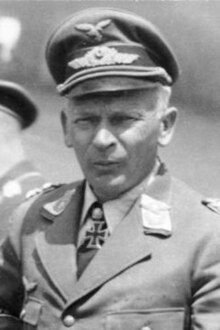Wolfram Freiherr von Richthofen
|
Dr.-Ing. Wolfram Freiherr von Richthofen |
|
|---|---|

Generalfeldmarschall Wolfram von Richthofen
|
|
| Born |
10 October 1895 Barzdorf, German Empire |
| Died | 12 July 1945 (aged 49) Bad Ischl, Austria |
| Allegiance |
|
| Years of service | 1913–20 1923–44 |
| Rank | Generalfeldmarschall |
| Unit | Jasta 11 |
| Commands held | Condor Legion, 8th Air Corps, Luftflotte 2, Luftflotte 4 |
| Battles/wars |
See battles
|
| Awards | Knight's Cross of the Iron Cross with Oak Leaves |
Wolfram Freiherr von Richthofen (10 October 1895 – 12 July 1945) was a German field marshal of the Luftwaffe (German Air Force) during the World War II. Born in 1895 into a family of the Prussian nobility, Richthofen grew up in prosperous surroundings. At the age of eighteen, after leaving school, he opted to join the German Army rather than choose an academic career, and joined the army's cavalry arm in 1913.
On the outbreak of the First World War, Richthofen fought on the Western Front, winning the Iron Cross Second Class. In 1915 he was posted to the Eastern Front, where he stayed until 1917. The Richthofen family produced several notable personalities that would become famous during the First War. His cousins, the brothers Lothar and Manfred von Richthofen both became flying aces and they encouraged him to join the Luftstreitkräfte (German Imperial Air Service). He did so, and joined Manfred's Geschwader (Wing), Jagdgeschwader 1 (Fighter Wing 1). Manfred, known as the Red Baron, was the highest scoring ace of the war, with 80 victories. On his first mission with his cousin, on 21 April 1918, Manfred was killed. Wolfram continued flying and went on to claim eight aerial victories before the armistice in November 1918. Lothar survived the war but was killed in a flying accident in 1922.
After the war Richthofen resumed civilian life after being discharged from the army. He studied Engineering at University before rejoining the Reichswehr, the German armed forces of the Weimar Republic era. In 1933 Hitler and the Nazi Party came to power in Germany, and the Reichswehr was transformed into the Wehrmacht. Richthofen joined the new Luftwaffe. He also served as part of the Condor Legion which supported the Nationalists in the Spanish Civil War. During this time, he recognised the need for close air support in military campaigns and championed the dive bomber, particularly the Junkers Ju 87 Stuka. He also believed in improving ground-air communications, which was put into effect in the Second World War, after his experiences in Spain and Poland. The combination of effective air-ground communications and powerful concentration of dive bombers would lead to personal success for Wolfram in the first half of the war. By 1941, a high standard of air to ground communications became a uniform facility in the Luftwaffe.
...
Wikipedia
